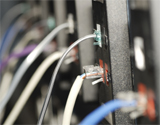IP surveillance is a definite trend, made possible through a reliable network. Fierce competition in the IP market offers more flexible networks to users. A&S looks at ways to build an efficient and cost-effective IP network.
IP surveillance is a definite trend, made possible through a reliable network. Fierce competition in the IP market offers more flexible networks to users.
A&S looks at ways to build an efficient and cost-effective IP network.
The market for network control devices has great potential, since the trend for IP systems is strong. "A wide range of verticals require advanced and innovative PoE switches, allowing the market to have unlimited growth potential," said Armine Beybutyan, Sales Manager at Korenix Technology. There is no need to worry for market saturation, because the demand for such products always exists.
Network control devices are categorized mainly as PoE switches and fiber optic transceivers. The PoE switch controls data transmission and the powering of network cameras, while the fiber optic transceiver coverts analog signals into light signals for long distance transmission.
PoE uses Cat 5 or Cat 6 cables, with two twisted-pair cables inside transmitting electricity and another two pairs transmitting data. In a pure IP environment, the simplest PoE switch can connect a number of IP edge devices and transfer their data back to the control center over one cable.
Depending on the installation, midspan, fiber optic or wireless device can be adopted. Video servers would be required, if analog cameras were part of a surveillance network formed by PoE switches.
If data needs to be transferred to remote locations, PoE switches can be connected to fiber optic cables through a media converter. Some PoE switches have built-in fiber optic ports for direct connections. If users wish to use fiber optic cable to transfer analog signals, then fiber optic transceivers can replace video servers and PoE switches. A right mix of these devices would build an IP network tailored for specific installations.
BenefitsNetwork control devices offer several benefits. Instead of connecting each edge device directly to the control center, adding these devices makes the system more cost-effective, flexible, future-proof and reliable.
When connected to network cameras, open-standard and low-cost PoE cables can reduce installation costs by eliminating power cords. The PoE switch can optimize the number of cameras connected, making the solution more cost-effective.
Costs are further reduced for fiber solutions, as fiber optic material costs less than copper wire for coaxial cables. Users with existing analog cameras can transfer data to remote locations over a fiber optic system at a lower cost, as signals do

not have to be boosted by a switch every 100 meters, said James Fuh, VP of Sales at LCSI.
Along with reduced cost, flexibility makes the solution more efficient. With network control devices, PoE supported cameras can be installed anywhere without power outlet restrictions, said Sunny Chen, Senior Product Manager at Ethernet Direct. Additional cameras or card readers could be added, making networks scalable.
Furthermore, since a stable network forms the backbone of an efficient security system, reliability is key. Fiber optic networking is known for its stable and smooth data transmission, preserving the data's original clarity, said Francis Jing, Manager of International Department at Tianjin Tiandy Digital Technology. Not only does signal transmission remain unaffected by outside factors, the data cannot be hacked.
PoE switches also makes networks more reliable by utilizing UPS, providing power redundancy. Companies such as Moxa, Korenix and LCSI have patented structure designs to optimize system reliability, providing transmission fallback.
"We are not just a network solution provider but the best partner for IP surveillance. We take the whole security system, including network cameras, into our consideration to ensure network reliability and quality of video transmission," said Beybutyan.
Applications
Network control devices can be installed for a range of applications, particularly ones with multiple sites requiring remote surveillance. Key verticals include transportation, industrial controls, military installations, agriculture, environmental monitoring and building automation.
Transportation is the biggest market for industrial PoE switches, said Fuh.

Surveillance for highways, bridges and tunnels often connect network cameras with PoE switches.
Customized solutions are required to meet the demands of different verticals. In mining, if the distance from one device to another is more than 100 meters, fiber optic cables and PoE switches could be utilized.
Latest Technology
PoE Switch Solution
As network control device technology has been on the market for a while, features such as reliability, efficiency and functionality are important.
Redundancy is important for reliable industrial PoE switches. In video surveillance, if the transmission recovery time takes longer than a second, it could result in a mosaic image. Now, network recovery times can be as low as five milliseconds and data transmission downtime during system maintenance can be minimized. Companies such as Korenix also offer seamless system restoration.
A patent ring structure for power or data transmission fallbacks further ensure reliability. "This kind of circle structure with fast data recovery was first used by electricity companies to provide fast power recovery. It was found later that it also worked well in network design," said Flanker Kuo, Senior Engineer, Asia Pacific and Taiwan at Moxa.
Preventing interference from outside disturbances is necessary, such as static electricity, lightning and unstable current supply. "We pick high class components and have special designs for PCB board and related components to make sure our products can operate in harsh and high EMS environments," said Kuo. Waterproof systems with the casing complying with IP 67 or IP 68 standards are also offered by some companies.
A durable industrial PoE switch can work in temperatures from 40 degrees Celsius below zero to 75 degrees Celsius, even with humidity of up to 95 percent. "Soon we will release a 19-inch rack mount PoE switch for control center applications that works in temperature environment up to 75 degrees Celsius," said Kuo.
Other than reliability, more powerful features are in development. Control functions with a user interface are being added to PoE switches. Users can authorize and

limit the bandwidth for each Ethernet port and know how much power is required for each edge device.
Some PoE switches can perform basic maintenance for network cameras, such as switching devices on or off. Scheduled power setup is popular for train and bus installations.
The power supply capability is optimized to expand system flexibility. Currently, the worldwide power standards for PoE switches are IEEE 802.3af (15.4 W) and IEEE8.2.3at (25 W). While the 30 W power standard is being finalized, some companies already offer 30 W PoE switches for IR and PTZ cameras. "We could power up almost all kinds of devices even if the power requirement does not comply with the standard," said Beybutyan.
Having PoE and fiber optic ports integrated on the same switch is a trend. Some devices have serial ports included, providing a platform for surveillance and access control integration. "A highly customized solution is a must, and we provide total solutions that allow IP surveillance to fit the requirements of different verticals," said Beybutyan.
Fiber Optic Solution Fiber optic solutions can reliably transfer more channels of multilayer signals and uncompressed data to distant locations with low cost, different from limited point-to-point single-layer transmission. Fiber optic transceivers could connect more channels and transfer data signals over 30 to 100 kilometers away, said Jing.
Currently, fiber transfers multilayer data and enables different levels of control authorization, making the solution more versatile, said Frank Liu, General Manager at Vadsys Digital Technologies. Uncompressed and compressed data such as MPEG-4 and H.264 could be transferred and processed.
Furthermore, IP systems with fiber optic transmission could transfer high quality images, making them convenient for customized solutions. "The broadcast method we use for the transportation vertical could transfer more than 100 lines of images by just one cable," said Liu.
Selection Criteria
Before deciding what solution is the best for an installation site, it is important to ensure it complies with the vertical's regulations and requirements. A commercial PoE switch that claims to offer 15.4 W must be able to offer 15.4 W to each individual port on the switch, said Fuh. A 15.4 W switch with four PoE ports should be able to offer 61.6 W total.
The PoE devices need to be certified for different verticals. Its features must be tested in the R&D department and pass a mass production quality check to

ensure compatibility with different installations, said Kuo. A minimum IP 30 rating for the outer casing and fanless design with a good heat dissipation mechanism are requirements for industrial PoE switches, said Chen.
When choosing a fiber optic system, suppliers should discuss with customers about the number of video, audio and data channels they need, including single mode or multimode, direction of data flow and the needed distance between two connectors, said Jing. The connecting ports also need surge protection, preventing electrical disturbances if lightning strikes.
A high-end device should have a redundant ring structure, reliability and high level of software intelligence. "In general, transportation would prefer fiber optic devices," said Beybutyan. "Airport and buildings would prefer integrated solutions, and PoE switches would be especially popular for trains."
Challenges
Although network control technology is mature, market education and serving the demands of diverse verticals are two key challenges for manufacturers.
Since network control devices can be installed in many different ways, many people are not familiar with how these devices could benefit them. "Users tend to choose from products they are used to," said Kuo. "Therefore, it is our job to train our distributors how to inform customers about the benefits of network control devices."
Other than user education, how to understand user's needs and customize the solution with a short time-to-market schedule are a challenge. Having comprehensive know-how about each industry and a strong R&D team to customize the solutions are crucial.
To achieve this, a dedicated consultancy team can provide consultation to customers prior to their purchase, making sure that customers get the most ideal solution for their particular application, said Chen. Strong two-way communication between the sales and R&D teams is a plus. In addition, recruiting a strong R&D team and building a reputation takes time and effort, said Liu.
Future Trends
Network control devices are part of the trend toward IP. In the future, fiber optic cables will support high-definition image data transfer, said Liu. More installations could add network control devices in their solutions. An industrial grade PoE switch could work in more harsh environments and its software would have more efficient management functions, said Kuo.
More efficient power supplies will be likely, as the amount of power per port will increase from original 15.4 W or 25 W to 30 W. The increased wattage could power up access control devices, PTZ cameras, industrial controlling devices, heat sensors, laptops and printers.